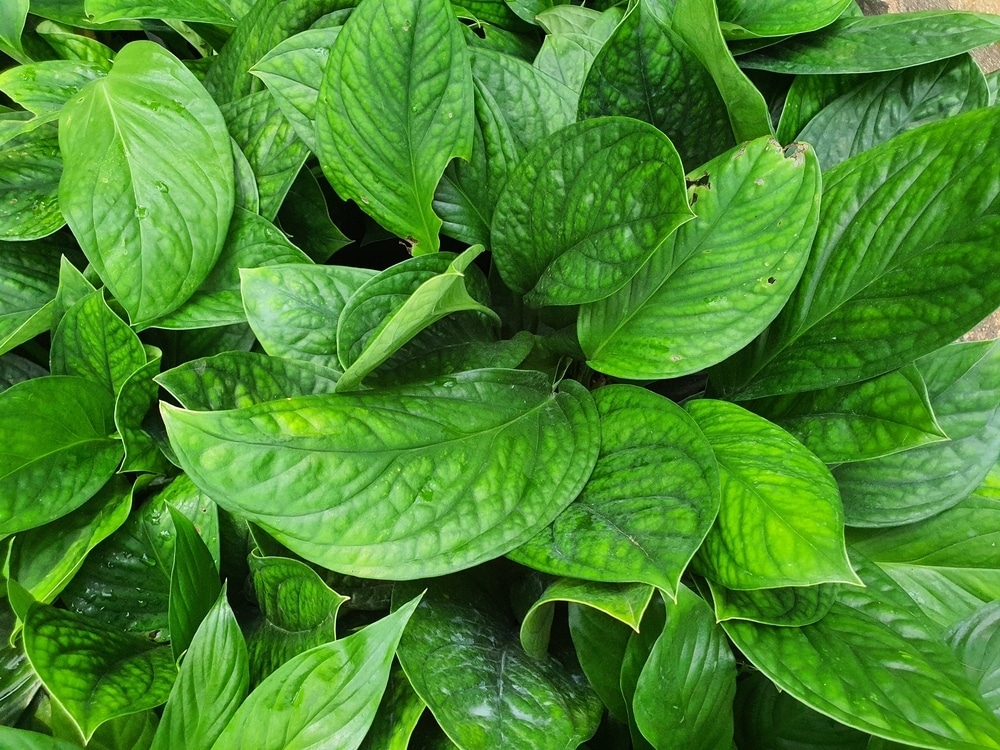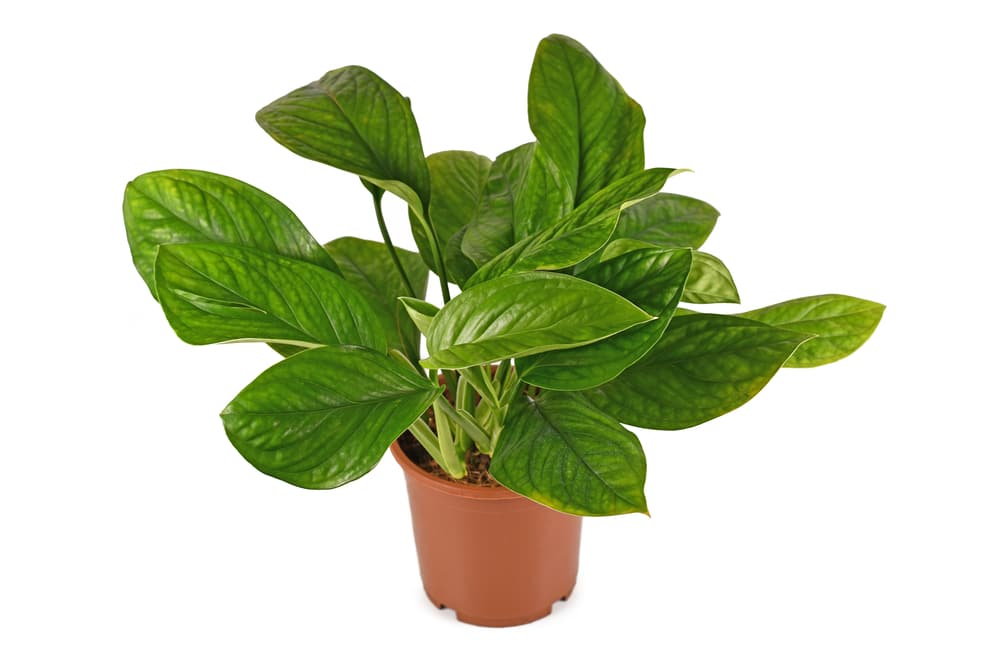Similar to its famous cousin, Monstera deliciosa, Monstera pinnatipartita is a climbing, shrub-like evergreen native to tropical regions of South America. Its ability to grow large, showy leaves makes it an ideal houseplant, and for more than one reason.
This monstera is a beautiful rendition of all that is tropical. Its leaves, though split, still maintain deep grooves that give the leaves texture on top of their size. Being a relatively slow grower, you won’t have to worry about much trimming or maintenance, which is great news for beginners!
So, what makes Monstera pinnatipartita such an ideal plant for indoor spaces? First, think about where it comes from. In South American rainforests, it’s warm, but not sweltering. The humidity helps keep the forests a bit cooler than above the canopy.
Next, the dappled sunlight that reaches beyond the vast tree canopies is similar to the level of light that comes in through the windows in our homes. When you compare the two vastly different climates, everything that this plant needs is about the same.
With the knowledge that houses are at least somewhat similar in climate to this monstera’s natural habitat, it’s easy to see why keeping one at home is fairly easy, and can be a fun experience for both beginners and experienced indoor gardeners alike. Here’s how to do it.

Light
As they creep up the trunks of bushy shade trees, Monstera pinnatipartita leaves receive bright, yet somewhat limited sunlight. The canopy foliage creates a dappled effect, meaning that the monstera does get some light, but it’s very diffused.
This same level of light can be imitated easily in a house or apartment, so long as you’ve got a window with plenty of morning sun and afternoon shade. If your windows are harbingers of direct sunlight, though, you’ll have to improvise.
To prevent sunburn on the leaves of your monstera, try diffusing the light from the nearest windows using sheer curtains, which block out most of the sun’s harshest rays, yet they llet just enough in to satiate the minimum for photosynthesis.
If natural light just doesn’t happen where you live, you can always opt for artificial light. It should be placed a couple of feet above the top foliage, but it doesn’t need to be a fancy blue and red light; full-spectrum LED lights usually do the trick.
Water
It might be more efficient for you to set a reminder on a schedule to water your Monstera pinnatipartita, but in reality, this is a setup for failure. The best way to tell when your plant actually needs water is to check the moisture level of the soil.
This can easily be accomplished by feeling the top third of the soil with your finger. Also simple and easy is using a moisture meter to tell you when the soil is 1/3rd dry, which indicates that it’s time to water.
Watering should be done once the plant’s top few inches of soil are mostly dry to the touch. Water thoroughly, but don’t let water sit in the bottom of the pot; this is a setup for root rot and fungus gnats, at the very least.
Make sure that any excess water is allowed to drain away from the pot freely, without sitting in a tray that allows the water to seep back into the soil. The idea is to maintain somewhat moist soil, but not allow it to become waterlogged or soggy at any time.

Soil & Potting
Let’s swing back around for a second to the way Monstera pinnatipartita climbs in nature. It grabs onto the bark of trees, grounding its aerial roots in the natural crevices that occur in that bark. Those same roots are responsible for gathering much of the plant’s water.
Thus, we must try to mimic that same general idea in a pot. To do this, use a very coarse soil mix, such as orchid bark, perlite or pumice, and something that holds moisture like coco coir. These components can be mixed in equal parts for DIY soil.
Monstera don’t typically need aeration in their pots the way other aeroid plants do; that being said, they do need to be potted in pots that have adequate drainage holes. These will allow plenty of airflow paired with the right soil.
As for the pot size, monstera plants don’t like too much room; they feel most grounded in silghtly smaller pots, which are large enough to hold all of their roots, but not so large that there’s lots of extra space between the roots and the sides of the pot.
Temperature & Humidity
Monstera pinnatipartita are very particular about their environment, so it’s important to maintain the right temperatures and humidity levels so that they feel at home. Providing them with their ideal temperature and humidity allows them to grow to their full potential.
The best temperature range for this monstera is anywhere from 60 degrees to 85 degrees fahrenheit, but it will tolerate some fluctuation so long as it isn’t extreme. Humidity plays a major role in the temperatures that Monstera pinnatipartita will tolerate.
Humidity is essential for the health of your Monstera pinnatipartita. Without it, aerial roots will have a hard time forming and growing as they should, which can hinder the overall growth of your plant.
To provide at least 50% humidity or higher, use a humidifier, pebble tray, or mist yout plant daily. Make sure that humidity isn’t applied when the plant is facing cold temperatures, which can increase the chill and potentially cause damage to the foliage.
Fertilizing
Monstera plants aren’t usually very heavy feeders, but they do require food during their most prominent growing seasons. There are several fertilizers on the market formulated specifically for monsteras, but if you’re not sure how much to use, it’s always best to feed less.
During the dormant season, use a diluted, balanced fertilizer once per month to help the plant produce new roots and strengthen existing stems. Then, when the plant comes out of dormancy and starts to put on lots of new growth, fertilizing should be done more frequently.
During the growing season, which may vary depending on where you live, your monstera plant will likely need to be fertilized once every two to three weeks with a well-balanced fertilizer. Make sure that you water prior to fertilizing with liquid fertilizer.
If you opt to use a slow-release fertilizer, read the instructions for use that come on the package. Always apply slightly less than the recommended dose to prevent burning of the roots. Be sure to flush out excess fertilizer once every six months or so for the same reason.
Pruning
As Monstera pinnatipartita is a climbing plant, it will tend to grow more up than out. If you have space limitations, pruning is a great way to keep your plant at a manageable size so that it doesn’t end up getting too big to care for indoors.
It’s best to prune at the very start of the growing season, but dead or dying leaves can be snipped away as they become discolored and begin to droop. Pruning off dead foliage helps the plant redirect its energy into more useful tasks, like making new leaves and roots.
To prune back your Monstera pinnatipartita for size reasons, choose how tall you’d like your plant to be after pruning, then cut just above the nearest node with clean, sharp shears. You can use the cuttings from your pruning to create even more plants!
Try not to prune during the dormant season unless you absolutely must, since doing so during this time of year will prevent the plant from recovering quickly or effectively. You can also train the vines on a moss pole to grow in a certain direction that works for you.
Suggested Read: Check out our step-by-step monstera propagation guide.

